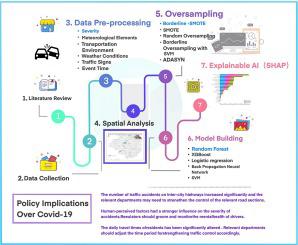Transportation Research Part A: Policy and Practice ( IF 6.3 ) Pub Date : 2023-12-29 , DOI: 10.1016/j.tra.2023.103947 Qiao Peng , Yassine Bakkar , Liangpeng Wu , Weilong Liu , Ruibing Kou , Kailong Liu

|
Transportation systems are critical lifelines and vulnerable to various disruptions, including unforeseen social events such as public health crises, and have far-reaching social impacts such as economic instability. This paper aims to determine the key factors influencing the severity of traffic accidents in four different stages during the pre- and the post Covid-19 pandemic in Illinois, USA. For this purpose, a Random Forest-based model is developed, which is combined with techniques of explainable machine learning. The results reveal that during the pandemic, human perceptual factors, notably increased air pressure, humidity and temperature, play an important role in accident severity. This suggests that alleviating driver anxiety, caused by these factors, may be more effective in curbing crash severity than conventional road condition improvements. Further analysis shows that the pandemic leads notable shifts in residents' daily travel time and accident-prone spatial segments, indicating the need for increased regulatory measures. Our findings provide new insights for policy makers seeking to improve transportation resilience during disruptive events.
中文翻译:

Covid-19 不确定性下的交通弹性:交通严重性分析
交通系统是重要的生命线,容易受到各种干扰,包括公共卫生危机等不可预见的社会事件,并产生经济不稳定等深远的社会影响。本文旨在确定影响美国伊利诺伊州 Covid-19 大流行前后四个不同阶段交通事故严重程度的关键因素。为此,开发了基于随机森林的模型,该模型与可解释的机器学习技术相结合。结果表明,在大流行期间,人类感知因素,特别是气压、湿度和温度的升高,在事故严重程度中发挥着重要作用。这表明,减轻由这些因素引起的驾驶员焦虑可能比传统的路况改善更有效地控制碰撞严重程度。进一步分析表明,疫情导致居民日常出行时间和事故易发空间区域发生显着变化,表明需要加强监管措施。我们的研究结果为寻求提高破坏性事件期间运输弹性的政策制定者提供了新的见解。


















































 京公网安备 11010802027423号
京公网安备 11010802027423号